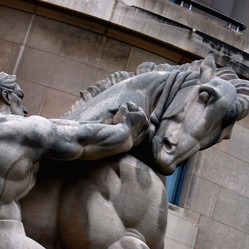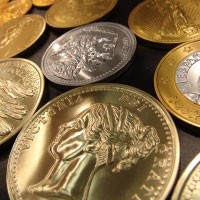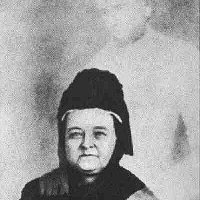Sculpture in churches provides another rich source of subjects. Fonts, effigies, decorations of roof bosses, and bas-reliefs offer an endless choice.
A rigid tripod is essential for taking photographs in a church; the use of a weak tripod may result in camera shake during long exposures. The roll film or miniature camera is quite adequate when taking photographs of subjects which have no verticals to be corrected, but, if there are verticals to correct, then the camera possessing the rise and swing movements is preferable. A telephoto lens is useful in obtaining close-ups of subjects out of reach of the normal focus lens, such as gargoyles and details in vaulted roofs, coats of arms, and the like.
Unless the church is well lit the photographer may have to provide his own lighting with portable equipment. Before attempting any photography the vicar's permission should be sought and, if lights are needed, the voltage of the electricity will have to be checked. Flashlighting is convenient, but the number of bulbs needed for good modelling is apt to be rather expensive. If a single flash is used on the camera, the lighting will be flat and will not show the form of the sculpture; if it is used away from the camera, the lighting will be too hard, unless a fill-in flash is used. Electronic flashes, fired from a succession of points during a time exposure, are an effective way out.
When daylight can be used, which is usually better than flash, the ideal outside lighting conditions are those on a bright day with no strong sunlight. The diffused lighting from such conditions is often preferable to strong sunlight, which would need a bright fill-in light to illuminate the shadow detail. In a church where the light comes from many directions, the lighting is apt to be very flat. A floodlight in this case could be used as the main light source, and the natural light act as a fill-in. In winter months the daylight intensity may change rapidly. An exposure meter should be used constantly to check this.
If a subject has to be photographed in very poor light, it will sometimes be found on developing the negative that, although the correct exposure was given according to the meter reading, it is still badly under-exposed. Digital photographs will tend to be somewhat grainy if the contrast and lightness is increased greater than 10%.










 Photographic Styleon 10/14/2011
Photographic Styleon 10/14/2011
 Interchangeable Lenseson 09/28/2011
Interchangeable Lenseson 09/28/2011
 Negative Blisters and Blemisheson 09/17/2011
Negative Blisters and Blemisheson 09/17/2011
 Photographyon 08/22/2011
Photographyon 08/22/2011


Comments
Great article. I was planning on doing some sculpture photography this week. You taught me some things I didn't know.